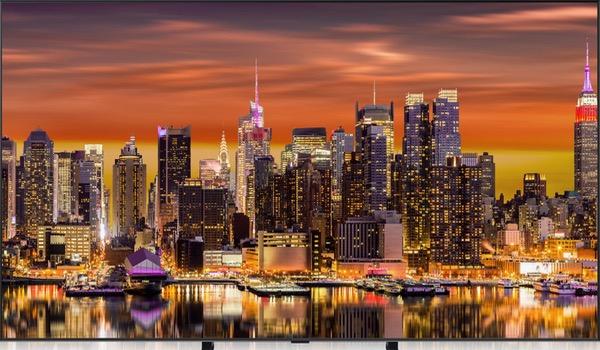Mr. Norton, I am very excited for the display tech on the horizon you mention here. That said, I’m also equally as excited about Hisense’s upcoming dual cell ULED XD display. Their solution to get OLED-like contrast with LED-backlit brightness is simply to use two overlapping LCD VA panels. On some level, it’s not as exciting as the cutting edge research going into micro LEDs and quantum dots, but we may end up with something similarly well performing, and much more financially viable in the short term.
Tech Update: Quantum Dots, Micro LEDs & Self-Emissive Displays

We don't usually attend the SID event, nor did we this year. Little of the arcana presented there will be of direct interest to our readers. But one topic covered at SID 2019 is worth noting. As summarized by a recent article in Insight Media, a trade publication, researchers are currently investigating the use of quantum dots for self-emissive displays. Self-emissive displays are currently a hot subject in video R&D. Another self-emissive development, demonstrated by Samsung and others in recent trade shows, uses super small LEDs, or as they're commonly known, Micro-LEDs. In such a display, the micro-LEDs themselves are the actual pixels.
While most Sound & Vision readers are intimately familiar with how current displays operate, a brief overview is perhaps useful here for the ever-present newbies. Today's most widely available and affordable display technology is LCD. While the LCD panel contains the pixels (individual picture elements) needed to produce the image, LCDs themselves emit no light and require some form of backlighting to generate a visible picture. In today's sets that backlighting comes mainly from LEDs (light emitting diodes) or a combination of LEDs and tiny elements known as quantum dots. In the former, white LEDs produce the light, which is later broken down by filters in the LCD panel into the red, green, and blue needed to produce the full color spectrum. In a set using quantum dots, light from blue LEDs energizes the quantum dots. To quote from a Samsung paper on the subject, "Quantum dot displays have a similar process of pixel color production. However, QD panels use blue LED light rather than white. The top layer of the display has red and green QDs and a blank pixel, rather than RGB color filter. The blue LED light is passed through the blank pixels to generate blue hues, while red and green QDs are in charge of red and green colors." But in both of these types of sets, neither the LEDs nor the quantum dots produce any picture detail; they'd be useless without the image provided by the LCD panel.
In a self-emissive display, however, the pixels themselves generate both the image and the light required. But only two types of current (or recent past) self-emissive displays are (or were) available to the consumer. Those displays are either OLEDs (today) or CRTs and plasmas (both now largely gone in the developed world).
The type of quantum dot lighting described above, as currently used for backlighting in many of today's sets, is called photoluminescent. But the ultimate goal for self-emissive quantum dot displays is electro luminescent, or ELQD. Simply put, the electro luminescent quantum dots themselves, excited by electrons, produce all three colors, eliminating the need for a blue LED. They're also small enough to be used for the actual pixels, making the entire display self-emitting. As in a self-emitting Micro LED display, this eliminates the need for an LCD panel and its inherent shortcomings, primarily limited contrast and compromised off-center viewing. As with today's OLEDs, Micro LEDs or quantum dots can be turned off almost instantaneously when black is required.
But there are problems in making either Micro-LED or ELQD sets commercially viable. With Micro-LEDs the primary issue is making them small enough to actually perform as individual pixels—a problem that the move to 8K will only exacerbate. That's why the Micro-LED displays seen at recent CESs have been huge. We've recently heard about least one upcoming, consumer-sized display from TCL using Mini-LEDs. But don't be confused by this. The Mini-LEDs in that set are used as backlighting, their size simply allowing for more local dimming zones than are typical. The latter is no small thing, and may offer real benefits. But such a Mini-LED set is not self-emissive, and not the same thing as a true, self-emissive, Micro-LED display.
On the self-emissive ELQD front, two main issues remain to be solved before such displays can be produced commercially: brightness and the effective operating life of the quantum dots themselves. At present the blue ELQDs, in particular, lack sufficient brightness and have an operating life well short of that required in a consumer display. To further complicate matters, the brighter they need to be (and high brightness capability is critical for today's HDR source material) the shorter their operating life.
If this limitation suggests a possible hybrid technology in which a blue OLED is used to excite red and green quantum dots, that's already being developed by at least two companies. Samsung calls its version QD-OLED, and TCL is working on what they call H-QLED. But other issues with this hybrid approach also remain to be worked out.
Nevertheless, serious efforts are currently underway to solve the problems that must be overcome before sets using any of these technologies come to market in popular sizes. Interestingly, quantum dots can employ processing equipment similar to that currently used for OLED displays. This might well put LG in the driver's seat to be first to market with a self-emissive, ELQD display. Samsung, however, is well along the path to consumer-friendly development of both Micro-LED and QD-LED sets. While they may not currently produce OLED televisions they still have considerable experience in producing OLED screens for cell phones. But we can't ignore the exploding Chinese display industry in this technology marathon; many of the relevant papers at that recent SID, including the one cited earlier, came from Chinese engineers and scientists.
In any event, don't expect to find such televisions on the market for at least a few years, and then they're likely to be pricey at first; cutting-edge products typically are. So if you need a new TV now, but insist on standing pat while hoping for that affordable, self-emissive quantum dot or a popularly-priced Micro-LED Ultra HDTV, it's likely to be a long wait.
- Log in or register to post comments


It's been a while since I've seen anything about the development of carbon nanotube technology for TV displays, with the last word being that further work needed to be done on it before it could ever hit mass production.
Is anyone talking about this anymore, or have these other technologies eliminated any more research into the application of carbon nanotubes?

"... In the former, red, green, and blue LEDs produce the light..."
I always thought the back light- LED or otherwise, is a white light and the LCD panel beaks it up into RGB.

The LED back light in LCD TVs is not RGB, the colors are produced by the LCD panel, not the back light.

In Sony sets with Quantum Dots , the backlights are actual RGB LEDs ! Instead of QLED they call their Quantum Dots TVs " TRILUMINUS" and they started to use them long before Samsung. The Samsung sets use blue LEDs for backlights.

No they're not- I do have a Sony "Triluminous' TV, and it uses edge lit local dimming. FYI, there is no such thing as RGB backlight.

I enjoyed this 'state of things' column, greatly appreciate an author willing to make corrections, and also like that S&V readers (I am one) are so astute. I'm not one of those Mr. Norton describes as "intimately familiar with how current displays operate" but need this education if I'm ever to replace my Pioneer Plasma.
































































